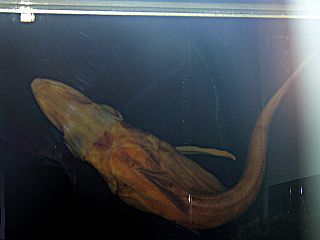The pink corydoras is a tropical freshwater fish belonging to the subfamily Corydoradinae of the family Callichthyidae. It originates in inland waters in South America, and is found in the Meta River basin in Colombia. A maximum body length of 4.2 cm has been reported. It was named in honor of pet-book publisher Herbert R. Axelrod (1927–2017), who helped collect type series and sent it to the Senckenberg Museum in Frankfurt, Germany.

Sundadanio axelrodi is a danionin in the family Cyprinidae, with origin from Borneo, Bangka, and Sumatra. Originally described as a rasbora, Rasbora axelrodi, this tiny species was later deemed to be more closely related to the danios but not enough to be moved into the genus Danio. Sundadanio axelrodi reaches a maximum size of 1.7 cm. Sundadanio was considered monotypic until the genus was reassessed by Conway, Kottelat and Tan in 2011.
George Sprague Myers was an American ichthyologist who spent most of his career at Stanford University. He served as the editor of Stanford Ichthyological Bulletin as well as president of the American Society of Ichthyologists and Herpetologists. Myers was also head of the Division of Fishes at the United States National Museum, and held a position as an ichthyologist for the United States Fish and Wildlife Service. He was also an advisor in fisheries and ichthyology to the Brazilian Government.
The pygmy hatchetfish is a species of hatchetfish native to Peru.
Ekemblemaria myersi, the reefsand blenny, is a species of chaenopsid blenny found from the Gulf of California to Colombia, in the eastern central Pacific ocean. It can reach a maximum length of 7 centimetres (2.8 in) TL. This species feeds primarily on zoobenthos. The specific name honours the ichthyologist George S. Myers (1905-1985) of Stanford University.

Axelrodia is a genus of small characin from the Amazon Basin and Meta River in South America, with three currently described species:
Schultzites is a genus of freshwater fish in the family Characidae. It contains the single species Schultzites axelrodi, which is endemic to Colombia, where it is found in the upper Meta River basin.
Klausewitzia ritae is a species of South American darter found in the upper Amazon River basin at the Peruvian/Brazilian border. It is the only member of the genus Klausewitzia.
Gerald Robert "Gerry" Allen is an American-born Australian ichthyologist. His career began in 1963, when he spent a semester at the University of Hawaii, where he also received a PhD in marine zoology in 1971. In 1972, Allen wrote his doctoral thesis on the systematics and biology of the anemone fish.
Bascanichthys myersi is an eel in the family Ophichthidae. It was described by Albert William Herre in 1932. It is a tropical, marine eel which is known from the western central Pacific Ocean, including Dumaguete, Negros Oriental, in the Philippines.
John Ernest "Jack" Randall was an American ichthyologist and a leading authority on coral reef fishes. Randall described over 800 species and authored 11 books and over 900 scientific papers and popular articles. He spent most of his career working in Hawaii. He died in April 2020 at the age of 95.

Caquetaia myersi is a species of fish, a large predatory cichlid, which is endemic to the basin of the Amazon River, specifically the Putumayo and Napo rivers of Ecuador and Colombia. The specific name honours the American ichthyologist George S. Myers (1905-1985) of Stanford University, who first noticed that this was a different species of fish but did not formally describe it. The fish is a protrusible-mouthed predator. The juveniles are omnivorous but the large adults are carnivorous.
Hyphessobrycon axelrodi is a species of tetra in the family Characidae.
Lubbockichthys is a genus of ray-finned fish from the Indo-Pacific region which belongs to the subfamily Pseudoplesiopinae, part of the family Pseudochromidae, the dottybacks. The species in this genus have small cycloid scales throughout their lives; some of their head bones have a weakly honeycombed surface; and the parietal bone encloses the rear section of the supratemporal laterosensory canal.
Phillip Clarence Heemstra was an American-South African ichthyologist. He was born in Melrose Park, Illinois, United States as the son of Clarence William Heemstra and his wife, Lydia. He attended school in Ottawa, Illinois, and completed a B.Sc. Zoology in 1963 at the University of Illinois at Urbana, Illinois, as well as his MSc degree (1968) and doctorate (1974) in marine biology at the University of Miami in Miami, Florida. He moved to live in South Africa in 1978.

Chionodraco myersi, the Myers's icefish, is a species of marine ray-finned fish belonging to the family Channichthyidae, the crocodile icefishes. It is found in the Southern Ocean.
Crenicichla isbrueckeri is a species of cichlid native to South America. It is found in the Amazon River basin and in the Aripuanã River basin. This species reaches a length of 9.5 cm (3.7 in).
Crenicichla pellegrini is a species of cichlid native to South America. It is found in the Amazon River basin and in the Aripuanã River basin. This species reaches a length of 15.7 cm (6.2 in).

Crenicichla regani is a species of cichlid native to South America. It is found in the Amazon River basin and in the Trombetas River at Cachoeira Porteira, Brazil. This species reaches a length of 7.9 cm (3.1 in).

Acnodon normani, the sheep-pacu, is a species of serrasalmids found in South America. It is found in the Amazon, the Xingu and Tocantins River basins in Brazil. This species reaches a length of 19.9 cm (7.8 in).





